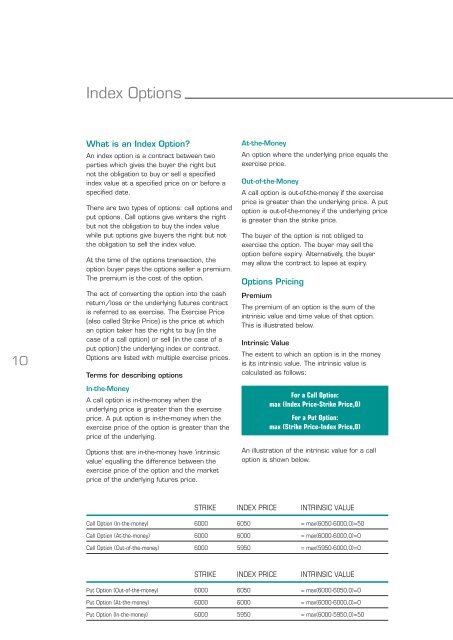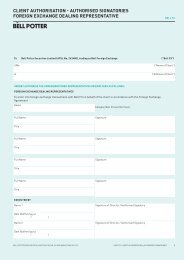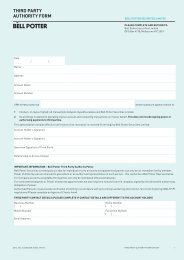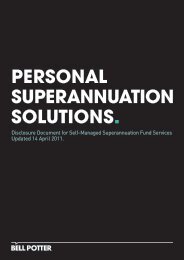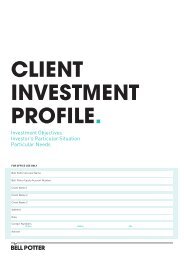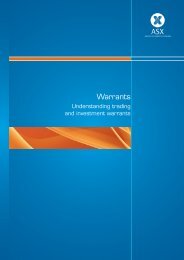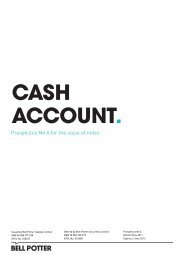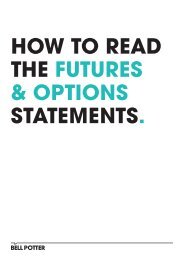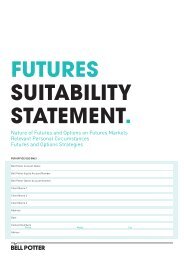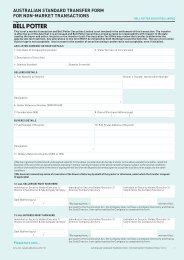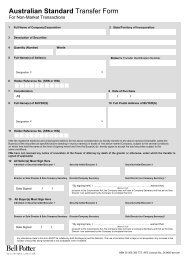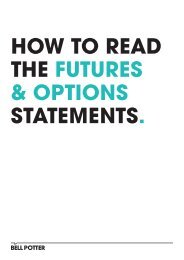Introduction to Index Futures and Options - Bell Potter Securities
Introduction to Index Futures and Options - Bell Potter Securities
Introduction to Index Futures and Options - Bell Potter Securities
You also want an ePaper? Increase the reach of your titles
YUMPU automatically turns print PDFs into web optimized ePapers that Google loves.
<strong>Index</strong> <strong>Options</strong><br />
10<br />
What is an <strong>Index</strong> Option<br />
An index option is a contract between two<br />
parties which gives the buyer the right but<br />
not the obligation <strong>to</strong> buy or sell a specified<br />
index value at a specified price on or before a<br />
specified date.<br />
There are two types of options: call options <strong>and</strong><br />
put options. Call options give writers the right<br />
but not the obligation <strong>to</strong> buy the index value<br />
while put options give buyers the right but not<br />
the obligation <strong>to</strong> sell the index value.<br />
At the time of the options transaction, the<br />
option buyer pays the options seller a premium.<br />
The premium is the cost of the option.<br />
The act of converting the option in<strong>to</strong> the cash<br />
return/loss or the underlying futures contract<br />
is referred <strong>to</strong> as exercise. The Exercise Price<br />
(also called Strike Price) is the price at which<br />
an option taker has the right <strong>to</strong> buy (in the<br />
case of a call option) or sell (in the case of a<br />
put option) the underlying index or contract.<br />
<strong>Options</strong> are listed with multiple exercise prices.<br />
Terms for describing options<br />
In-the-Money<br />
A call option is in-the-money when the<br />
underlying price is greater than the exercise<br />
price. A put option is in-the-money when the<br />
exercise price of the option is greater than the<br />
price of the underlying.<br />
<strong>Options</strong> that are in-the-money have ‘intrinsic<br />
value’ equalling the difference between the<br />
exercise price of the option <strong>and</strong> the market<br />
price of the underlying futures price.<br />
At-the-Money<br />
An option where the underlying price equals the<br />
exercise price.<br />
Out-of-the-Money<br />
A call option is out-of-the-money if the exercise<br />
price is greater than the underlying price. A put<br />
option is out-of-the-money if the underlying price<br />
is greater than the strike price.<br />
The buyer of the option is not obliged <strong>to</strong><br />
exercise the option. The buyer may sell the<br />
option before expiry. Alternatively, the buyer<br />
may allow the contract <strong>to</strong> lapse at expiry.<br />
<strong>Options</strong> Pricing<br />
Premium<br />
The premium of an option is the sum of the<br />
intrinsic value <strong>and</strong> time value of that option.<br />
This is illustrated below.<br />
Intrinsic Value<br />
The extent <strong>to</strong> which an option is in the money<br />
is its intrinsic value. The intrinsic value is<br />
calculated as follows:<br />
For a Call Option:<br />
max (<strong>Index</strong> Price-Strike Price,0)<br />
For a Put Option:<br />
max (Strike Price-<strong>Index</strong> Price,0)<br />
An illustration of the intrinsic value for a call<br />
option is shown below.<br />
Strike <strong>Index</strong> Price Intrinsic Value<br />
Call Option (In-the-money) 6000 6050 = max(6050-6000,0)=50<br />
Call Option (At-the-money) 6000 6000 = max(6000-6000,0)=0<br />
Call Option (Out-of-the-money) 6000 5950 = max(5950-6000,0)=0<br />
Strike <strong>Index</strong> Price Intrinsic Value<br />
Put Option (Out-of-the-money) 6000 6050 = max(6000-6050,0)=0<br />
Put Option (At-the-money) 6000 6000 = max(6000-6000,0)=0<br />
Put Option (In-the-money) 6000 5950 = max(6000-5950,0)=50


